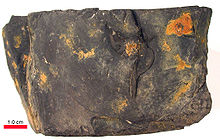- Coal oil
-
Coal oil is a term once used for a specific shale oil used for illuminating purposes.[citation needed] Coal oil is obtained from the destructive distillation of cannel coal, mineral wax, and bituminous shale, while kerosene is obtained by the distillation of petroleum. A special type of coal known as cannel coal (classified also as terrestrial type of oil shale) is required to produce it.[citation needed]
Coal oil was first produced in 1850 by James Young on the Union Canal in Scotland. He was the first to patent the process of distilling this cannel coal into kerosene. This industry thrived in Scotland, creating much wealth for Young.
It consists mainly of several hydrocarbons of the alkane series, having from 10 to 16 carbon atoms in each molecule, and having a higher boiling point (175–325°C) than gasoline or the petroleum ethers, and a lower boiling point than the oils. Early belief that kerosene was produced from coal led to kerosene being popularly referred to as "coal oil."[1][2][3] This is a technicality, however, because hydrocarbons of the alkane series, with 10 to 16 carbon atoms, when refined, is the same thing whether taken from coal or petroleum.
Home remedy
Coal oil was once used as an internal and topical home remedy as a general cure-all for myriad ailments, including coughs, flu, cuts, abrasions, and wounds. Internal applications were administered by adding this decidedly toxic petroleum product to sugar cubes, molasses, honey or some other substance to mask the taste, while topical applications were applied adding to bandages or by pouring the coal oil directly on the affected area.[4]
See also
- Kerosene
- Patent medicine
- Abraham Pineo Gesner, produced kerosene from coal, 1846
- Shale oil extraction
References
- ^ Evelyn Richardson (20 October 2009). "Here and There: Call It Coal oil or kerosene, Fuel Still Has Its Uses". Logan County (Kentucky) News-Democrat & Leader. http://www.newsdemocratleader.com/pages/full_story/push?article-Here+and+There-+Call+it+coal+oil+or+kerosene-+fuel+still+has+its+uses%20&id=4062865-Here+and+There-+Call+it+coal+oil+or+kerosene-+fuel+still+has+its+uses&instance=special_coverage_bullets_right_column. Retrieved 9 January 2011.
- ^ Maris, Clarence (1921). "Lesson 4, The Coal Oil or Kerosene Lamp.". Dangers and chemistry of fire, for grammar schools. Columbus, Ohio: The F.J. Heer Printing Company. http://books.google.com/books?id=JIJIAAAAMAAJ&pg=PA9&dq=%22coal+oil+lamp%22+kerosene&lr=&as_brr=3&cd=3#v=onepage&q=%22coal%20oil%20lamp%22%20kerosene&f=false. Retrieved 9 January 2011.
- ^ Drake, Paul (2004). "Definition of "coal oil" as common term for kerosene". What Did They Mean By That? A Dictionary of Historical and Genealogical Terms, Old and New. Heritage Books, Inc. p. 60. ISBN 978-0788425004. http://books.google.com/books?id=ZPOLC9inmYUC&pg=RA1-PA60&dq=%22coal+oil+lamp%22+kerosene&lr=&as_brr=3&cd=22#v=onepage&q=%22coal%20oil%20lamp%22%20kerosene&f=false. Retrieved 9 January 2011.
- ^ Delbert Trew (15 June 2007). "Coal Oil Was Useful All-Purpose Home Remedy". Texas Escapes. Blueprints For Travel, LLC.. http://www.texasescapes.com/DelbertTrew/Coal-Oil-Home-Remedy.htm. Retrieved 9 January 2011.
Categories:- Oils
- Oil shale
- Biologically based therapies
Wikimedia Foundation. 2010.

